key MERCEDES-BENZ V-CLASS MPV 2021 Owner's Manual
[x] Cancel search | Manufacturer: MERCEDES-BENZ, Model Year: 2021, Model line: V-CLASS MPV, Model: MERCEDES-BENZ V-CLASS MPV 2021Pages: 337, PDF Size: 9.88 MB
Page 71 of 337
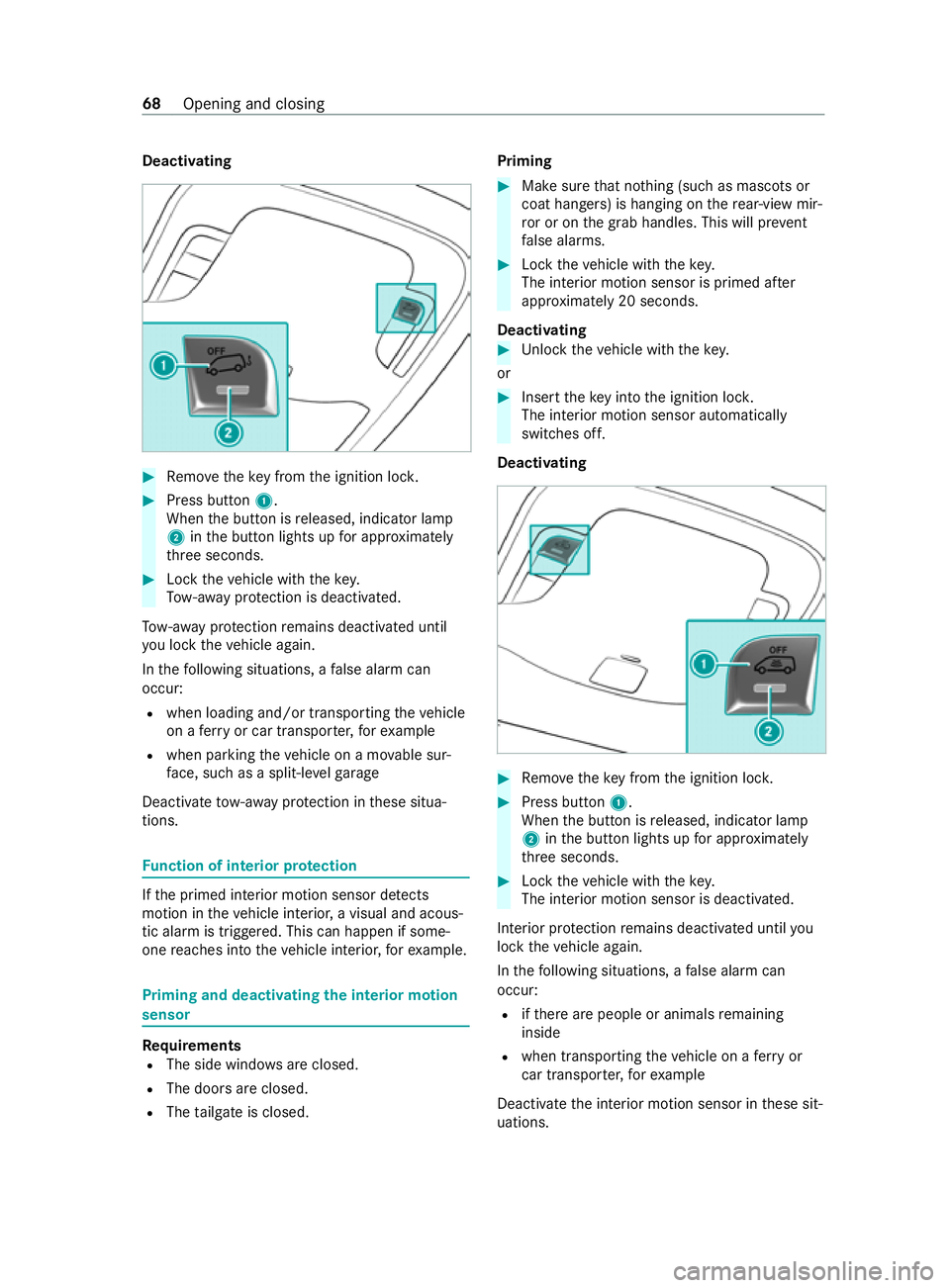
Deactivating
#
Remo vetheke y from the ignition loc k. #
Press button 1.
When the button is released, indicator lamp
2 inthe button lights up for appro ximately
th re e seconds. #
Lock theve hicle with thekey.
To w- aw ay protection is deactivated.
To w- aw ay protection remains deactivated until
yo u lock theve hicle again.
In thefo llowing situations, a false alarm can
occur:
R when loading and/or transporting theve hicle
on a ferry or car transpor ter,fo rex ample
R when parking theve hicle on a mo vable sur‐
fa ce, such as a split-le velga rage
Deactivate tow- aw ay protection in these situa‐
tions. Fu
nction of interior pr otection If
th e primed interior motion sensor de tects
motion in theve hicle interior, a visual and acous‐
tic alarm is triggered. This can happen if some‐
one reaches into theve hicle interior, forex ample. Priming and deactivating
the interior motion
sensor Requ
irements
R The side windo wsare closed.
R The doors are closed.
R The tailgate is closed. Priming #
Make sure that no thing (such as masc ots or
coat hangers) is hanging on there ar-view mir‐
ro r or on the grab handles. This will pr event
fa lse alarms. #
Lock theve hicle with thekey.
The interior motion sensor is primed af ter
appr oximately 20 seconds.
Deactivating #
Unlock theve hicle with thekey.
or #
Insert theke y into the ignition loc k.
The interior motion sensor automatically
switches off.
Deactivating #
Remo vetheke y from the ignition loc k. #
Press button 1.
When the button is released, indicator lamp
2 inthe button lights up for appro ximately
th re e seconds. #
Lock theve hicle with thekey.
The interior motion sensor is deactivated.
Interior pr otection remains deactivated until you
lock theve hicle again.
In thefo llowing situations, a false alarm can
occur:
R ifth ere are people or animals remaining
inside
R when transporting theve hicle on a ferry or
car transpor ter,fo rex ample
Deactivate the interior motion sensor in these sit‐
uations. 68
Opening and closing
Page 74 of 337

#
Pull le ver1 upwards and slide the seat for‐
wa rds or back until the desired position has
been reached. #
Release le ver1 and push the seat back or
fo rw ards until you hear the seat engage.
% Fo
r front swivel seats, the le ver in position
1 is used torelease the swivel seat. The
le ve rto adjust thefo re -and-aft position is in
th efo rm of a bar in front of the seat
(/ page 74).
Ad justing the seat height #
Pull or push le ver3 repeatedly until the
desired seat height has been reached.
Ad justing the seat backrest #
Turn handwheel 4forw ards.
The seat backrest will mo vetoave rtical posi‐
tion. #
Turn handwheel 4backwards.
The seat backrest will tilt bac k.
Ad justing the seat angle #
Turn handwheel 2forw ards.
The front of the seat cushion will tilt down. #
Turn handwheel 2backwards.
The front of the seat cushion will tilt up. Ad
justing the front seat electrically &
WARNING Risk of becoming trapped if
th e seats are adjus tedby children
Children could become trapped if they adjust
th e seats, particularly when unattended. #
When leaving theve hicle, alw aysta ke
th eke y with you and lock theve hicle. #
Never lea vechildren unat tended in the
ve hicle. The seats can be adjus
ted when there is no key in
th e ignition loc k. &
WARNING Risk of injury ifve hicle set‐
tings are adjus ted while theve hicle is in
motion
Yo u could lose control of theve hicle in partic‐
ular in thefo llowing situations:
R Ifyo u adjust the driver's seat, the head
re stra ints, thesteering wheel or the mir‐
ro r while theve hicle is in motion.
R Ifyo ufast enyour seat belt while theve hi‐
cle is in motion. #
Before starting the engine: adjust the
driver's seat, head restra ints, steering
wheel and mir ror in particular and fas‐
te nyo ur seat belt. &
WARNING Risk of becoming trapped dur‐
ing seat adjustment
When you adjust a seat, you or other vehicle
occupants could become trapped, e.g. on the
seat guide rail. #
Make sure when adjusting a seat that
no one has any body parts in the sweep
of the seat. Obser
vethe saf ety no tes on "Airbags" and "Chil‐
dren in theve hicle". &
WARNING Risk of injury or death dueto
th e front seat being positioned too close
to the cockpit
The front airbags can also injure the occu‐
pants in the front of theve hicle. #
Always adjust the front seats so they
are as faraw ay as possible from the
front airbags. #
In addition, obser vethe no tes on cor‐
re ct seat adjustment. &
WARNING Risk of injury or death dueto
incor rect seat position
The seat belt will not of ferth e intended le vel
of pr otection if you ha venot mo vedth e seat
backrest toan almost vertical position.
In particular, you may slip under the seatbelt
and injure yourself. #
Adjust the seat properly before begin‐
ning your journe y. #
Always ensure that the seat backrest is
in an almost vertical position and that Seats and
stowage 71
Page 100 of 337

The
following can be found in thestow age com‐
partment of the cent reconsole depending on the
car's equipment:
R A12 V soc ket (/ page 102) or the cigar ette
lighter (/ page102)
R The Media In terface with two USB ports or
with two USB ports and one SD card slot
R The holder forth e mobile phone cradle
R The ashtray (/ page101)
R Astow age compartment or a device ins talla‐
tion frame for auxiliary equipment, e.g. a
ta ch ograph
Opening and closing thest ow age comp art‐
ment under the armrest #
Toopen: press button 1.
The stow age compartment opens. #
Toclose: presstoclose the caps of thestow‐
age compartment in any order.
Opening and closing thegl ove compa rtment &
WARNING Risk of injury duetoobjects
being stowed incor rectly
If objects in theve hicle interior are stowed
incor rectly, they can slide or be thrown
around and hit vehicle occupants. In addition,
cup holders, open stowage spaces and
mobile phone brac kets cannot al waysretain
all objects they contain.
The reis a risk of injur y,particular lyin the
eve nt of sudden braking or a sudden change
in direction. #
Alwaysstow objects in such a wayth at
th ey cannot be thro wn around in such
situations. #
Always make sure that objects do not
pr otru de from stowage spaces, luggage
nets or stowage nets. #
Close the loc kable stow age spaces
before starting a journe y. #
Alwaysstow and secure heavy, hard,
poin ted, sharp-edged, fragile or bulky
objects in the boot. Comply with
the instructions for loading theve hi‐
cle. 0047
Unloc ked
0048 Locked
3 Glovecompa rtment handle #
Tolock/unlock: turnthe emer gency key a
qu arter turn anti-clockwise 0048(to lock) or
clockwise 0047(to unlock). #
Toopen: pullglov e compartment handle 3
in the direction of the ar row. #
Toclose: fold theglove compa rtment handle
up and press it until it engages.
Using thesto wage net on the seat backrest #
Store lightweight small parts in thestow age
nets.
% On front seats with seat
ventilation, make
su re that no objects pr otru de out of thestow‐
age net and co verth e seat ventilation air inl et
abo ve.
Opening thegl asses comp artment Seats and
stowage 97
Page 128 of 337

Con
venience opening/closing &
WARNING Risk of entrapment due tonot
paying attention duri ng convenience clos‐
ing
When the con venience closing feature is
operating, parts of the body could become
trapped in the closing area of the side win‐
do ws. #
When the con venience closing feature is
operating, monitor the entire closing
process and make sure that no body
parts are in the closing area. &
WARNING Risk of entrapment from the
con venience opening feature
During con venience opening pa rts of the
body could be dr awn in or become trapped
between the side window and window frame. #
When opening, make sure that nobody
is touching the side windo ws. #
If someone becomes trapped, immedi‐
ately press the0062 button in the door
to open the side windo ws.
The side windo ws stop. #
Tocontinue closing the side windo ws,
pull on the0062 button. #
Con venience closing with the air recircu‐
lation rocker switch: press and hold the
0072 rocker switch up or down until the side
windo wsclose au tomatically.
The indica tor lamp abo vethe0072 rock er
switch lights up. The initial position of the
side windo wsis sa ved. Air-recirculation mode
is activated.
If yo u open the side windo wsmanually af ter
closing them with the con venience closing
fe ature, they will open automatically as far as
th est art position before the con venience
closing. #
Conve nience opening with the air-recircu‐
lation rocker switch: press and hold the
0072 rocker switch up or down until the side
windo wsopen automatically.
The indicator lamp abo vethe0072 rock er
switch goes out. Air-recirculation mode will
be deactivated. #
Pre-entry climate control and con veni‐
ence opening with theke y:press and hold
th e0036 button on thekey.
The side windo wsopen automatically and the
blo wer of the climate cont rol sy stem is activa‐
te d. Switching
there ar window heater on/off The
rear wind owheater consumes a lot of elec‐
tricity. You should therefore switch off there ar
wind owheater as soon as there ar wind owis
clear. #
Swit chon the ignition. #
Press theto p or bottom of the006C rocker
switch.
If th e indicator lamp abo vethe006C rock er
switch lights up, there ar wind owheater is
switched on.
The rear wind owheater will switch off automati‐
cally af ter a few minutes. Switching
there sidual heat utilisation on/off When
the engine is switched off, it is possible to
make use of there sidual heat of the engine to
heat or ventilate theve hicle interior for appro x‐
ima tely 30 minutes. The heating or ventilation
time depends on the set vehicle interior temp era‐
ture. #
Switch off the engine or remo vethekey. #
Toswitch on: presstheto p or bottom sec‐
tion of the! rocker switch.
When residual heat utilisation is switched on,
th e indicator lamp abo vethe! rocker
switch will light up.
The blo wer will run at a low speed rega rdless
of the air flow setting.
If th e "Residual heat" function is switched on
at high outside temp eratures, only thest a‐
tionary ventilation will be switched on. The
bl owe r will then run at medium speed. #
Toswitch off: presstheto p or bottom sec‐
tion of the! rocker switch again.
The indicator lamp abo vethe! rock er
switch goes out. Climate control
12 5
Page 139 of 337
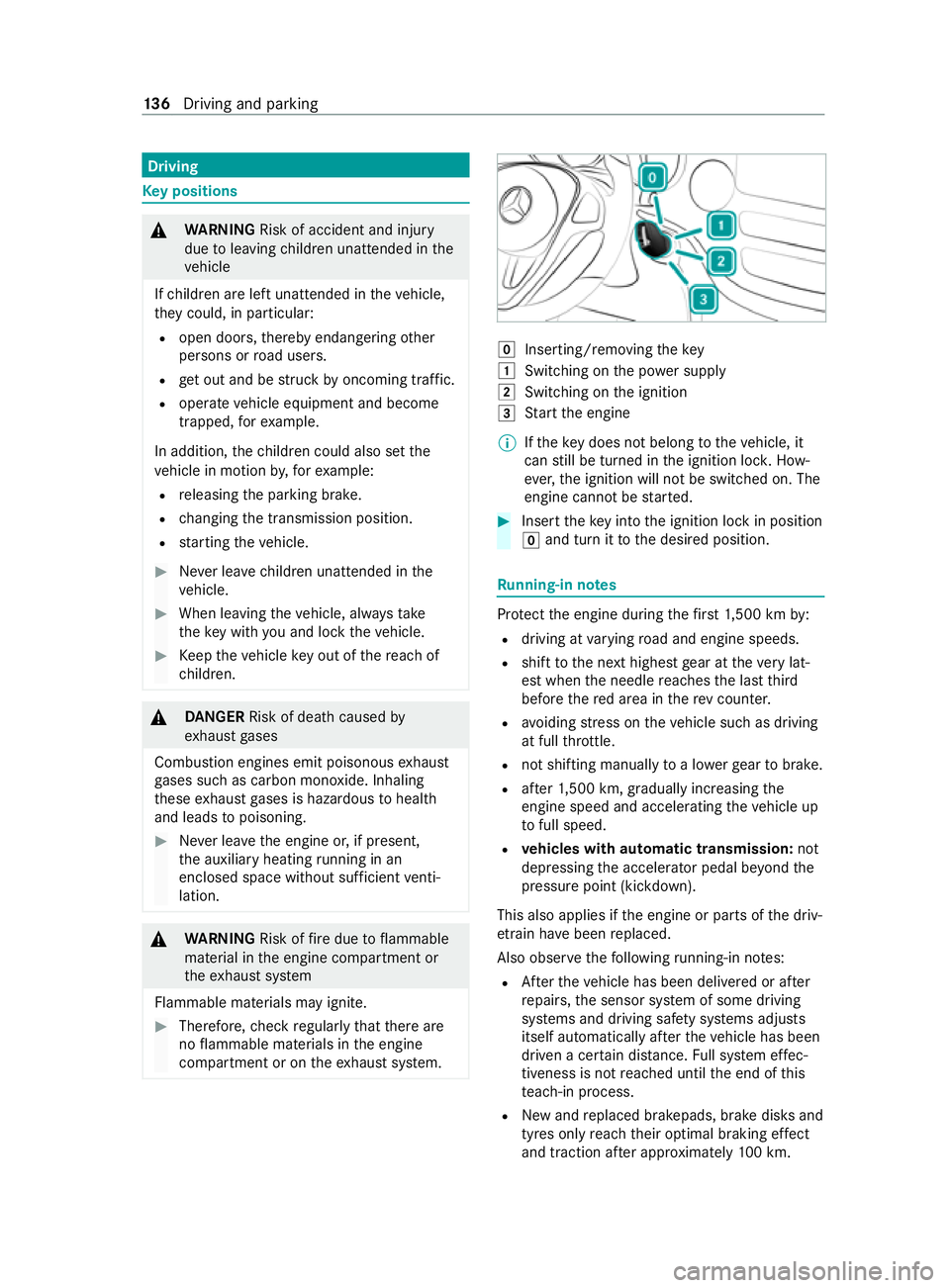
Driving
Ke
y positions &
WARNING Risk of accident and inju ry
due toleaving children unat tended in the
ve hicle
If ch ildren are left unat tended in theve hicle,
th ey could, in part icular:
R open doors, thereby endangering other
persons or road users.
R get out and be stru ck byoncoming traf fic.
R operate vehicle equipment and become
trapped, forex ample.
In addition, thech ildren could also set the
ve hicle in motion by,fo rex ample:
R releasing the parking brake.
R changing the transmission position.
R starting theve hicle. #
Never lea vechildren unat tended in the
ve hicle. #
When leaving theve hicle, alw aysta ke
th eke y with you and lock theve hicle. #
Keep theve hicle key out of there ach of
ch ildren. &
DANG ER Risk of death caused by
ex haust gases
Combustion engines emit poisonous exhaust
ga ses such as carbon monoxide. Inhaling
th ese exhaust gases is hazardous tohealth
and leads topoisoning. #
Never lea vethe engine or, if present,
th e auxiliary heating running in an
enclosed space wi thout suf ficient venti‐
lation. &
WARNING Risk offire due toflammable
material in the engine compartment or
th eex haust sy stem
Flammable materials may ignite. #
Therefore, check regularly that there are
no flammable materials in the engine
compartment or on theex haust sy stem. 005A
Inserting/ removing thekey
0047 Switching on the po wer supp ly
0048 Switching on the ignition
0049 Start the engine
% If
th eke y does not belong totheve hicle, it
can still be turned in the ignition loc k.How‐
eve r,th e ignition will not be switched on. The
engine cann otbe star ted. #
Insert theke y into the ignition lock in position
005A and turn it tothe desired position. Ru
nning-in no tes Pr
otect the engine during thefirs t1, 500 km by:
R driving at varying road and engine speeds.
R shift tothe next highest gear at theve ry lat‐
est when the needle reaches the last third
before there d area in there v counter.
R avoiding stre ss on theve hicle such as driving
at full thro ttle.
R not shi fting manually toa lo werge ar to brake.
R afte r1, 500 km, gradually increasing the
engine speed and accelerating theve hicle up
to full speed.
R vehicles with automatic transmission: not
depressing the accelerator pedal be yond the
pressure point (kickdown).
This also applies if the engine or parts of the driv‐
et ra in ha vebeen replaced.
Also obser vethefo llowing running-in no tes:
R Afterth eve hicle has been delivered or af ter
re pairs, the sensor sy stem of some driving
sy stems and driving saf ety sy stems adjusts
itself automatically af terth eve hicle has been
driven a cer tain dis tance. Full sy stem ef fec‐
tiveness is not reached until the end of this
te ach-in process.
R New and replaced brakepads, brake disks and
tyres only reach their optimal braking ef fect
and traction af ter appro ximately 10 0 km. 13 6
Driving and pa rking
Page 145 of 337

Au
tomatic transmission DIRECT SELECT le
ver Fu
nction of the DIRECT SELECT le ver &
WARNING Risk of accident and inju ry
due toleaving children unat tended in the
ve hicle
If ch ildren are left unat tended in theve hicle,
th ey could, in part icular:
R open doors, thereby endangering other
persons or road users.
R get out and be stru ck byoncoming traf fic.
R operate vehicle equipment and become
trapped, forex ample.
In addition, thech ildren could also set the
ve hicle in motion by,fo rex ample:
R releasing the parking brake.
R changing the transmission position.
R starting theve hicle. #
Never lea vechildren unat tended in the
ve hicle. #
When leaving theve hicle, alw aysta ke
th eke y with you and lock theve hicle. #
Keep theve hicle key out of there ach of
ch ildren. &
WARNING Risk of accident due toincor‐
re ct gearshifting
If th e engine speed is higher than the idle
speed and you engage the transmission posi‐
tion 005Bor005E, theve hicle may accelerate
sharply. #
Ifyo u engage the transmission position
005B or005E when theve hicle is at a stand‐
st ill, alw ays depress the brake pedal
fi rm lyand do not accelerate at the
same time. Ve
hicles with 7-speed automatic transmis‐
sion: &
WARNING Risk of accident due tothe
ve hicle rolling away
When the engine is switched off, the auto‐
matic transmission shifts into neutral position
005C. #
Always shift topark position 005Dbefore
switching off the engine. #
Secure against rolling away with the
parking brake. *
NO
TETransmission damage due toshift‐
ing at high engine speed or when the
ve hicle is rolling Yo
u can damage the automatic transmission
if yo u shift from 005Bto005E , from 005Eto005B or
directly to005D when the engine speed is too
high or theve hicle is rolling. #
Only change the transmission position
when theve hicle is stationar y. Depending on
the transmission, the automatic
transmission switches totransmission position
005D (9-speed au tomatic transmission) or005C (7-
speed automatic transmission) when switching
off the engine. The po wer transmission between
th e engine and transmission is inter rupte d in
transmission position 005C. Inthis case, shift the
automatic transmission totransmission position
005D before switching off the engine when theve hi‐
cle is stationar y.Obser vethe messages on the
multifunction displa y.App lythe parking brake to
pr eve nttheve hicle from rolling away.
Yo u use the DIRECT SELECT le verto switch the
transmission position. The cur rent transmission
position appears in the multifunction display
(/ page 182). 005D
Park position
005E Reversege ar
005C Neut ral
005B Drive position 14 2
Driving and pa rking
Page 153 of 337

Re
fuelling with a refill canis ter Example
#
Unscr ewthe cap on AdBlue ®
re fill canis ter
1 . #
Screw disposable hose 2onto the opening
of Ad Blue ®
re fill canis ter1 until hand-tight. #
Screw disposable hose 2onto thefiller neck
of theve hicle until hand-tight. #
Lift up and tip AdBlue ®
re fill canis ter1.
The filling process stops when theAd Blue ®
ta nk is comple tely full.
Ad Blue ®
re fill canis ter1 can be remo ved
when it has been only partially em ptied.
% Avoid storing AdBlue ®
containers perma‐
nently in theve hicle. #
Unscr ewdisposable hose 2inreve rse order
from AdBlue ®
re fill canis ter1 and thefiller
neck of theve hicle.
Closing theAd Blue ®
filler cap #
Afterfilling theAd Blue ®
tank, place the
Ad Blue ®
filler cap on thefiller neck and
tigh ten it clo ckwise. #
Turn theAd Blue ®
filler cap until the lettering
is legible and horizontal.
The filler neck is only loc ked cor rectly when
th is is the case. #
Open the front left-hand door firs t, and then
close thefiller flap. #
Swit chon the ignition.
The Refill AdBlue See Owner's Manual mes‐
sage in the multifunction display must go out
af te r appro x. 20 seconds. If the message con‐ tinues
tobe displa yed, you must add more
Ad Blue ®
. Park
ing Pa
rking theve hicle &
WARNING Risk offire caused byhot
ex haust sy stem parts
Flammable materials such as lea ves, grass or
twigs may ignite. #
Park theve hicle so that no flammable
material can come into con tact with hot
ve hicle components. #
In particular, do not park on dry grass‐
land or har vested grain fields. &
WARNING Risk of accident and injury
due toleaving children unat tended in the
ve hicle
If ch ildren are left unat tended in theve hicle,
th ey could, in part icular:
R open doors, thereby endangering other
persons or road users.
R get out and be stru ck byoncoming traf fic.
R operate vehicle equipment and become
trapped, forex ample.
In addition, thech ildren could also set the
ve hicle in motion by,fo rex ample:
R releasing the parking brake.
R changing the transmission position.
R starting theve hicle. #
Never lea vechildren unat tended in the
ve hicle. #
When leaving theve hicle, alw aysta ke
th eke y with you and lock theve hicle. #
Keep theve hicle key out of there ach of
ch ildren. *
NO
TEDama getotheve hicle or the drive‐
train due torolling away #
Always park your vehicle safely and
according tolegal requirements. #
Always proper lysecure theve hicle
against rolling away. 15 0
Driving and pa rking
Page 154 of 337
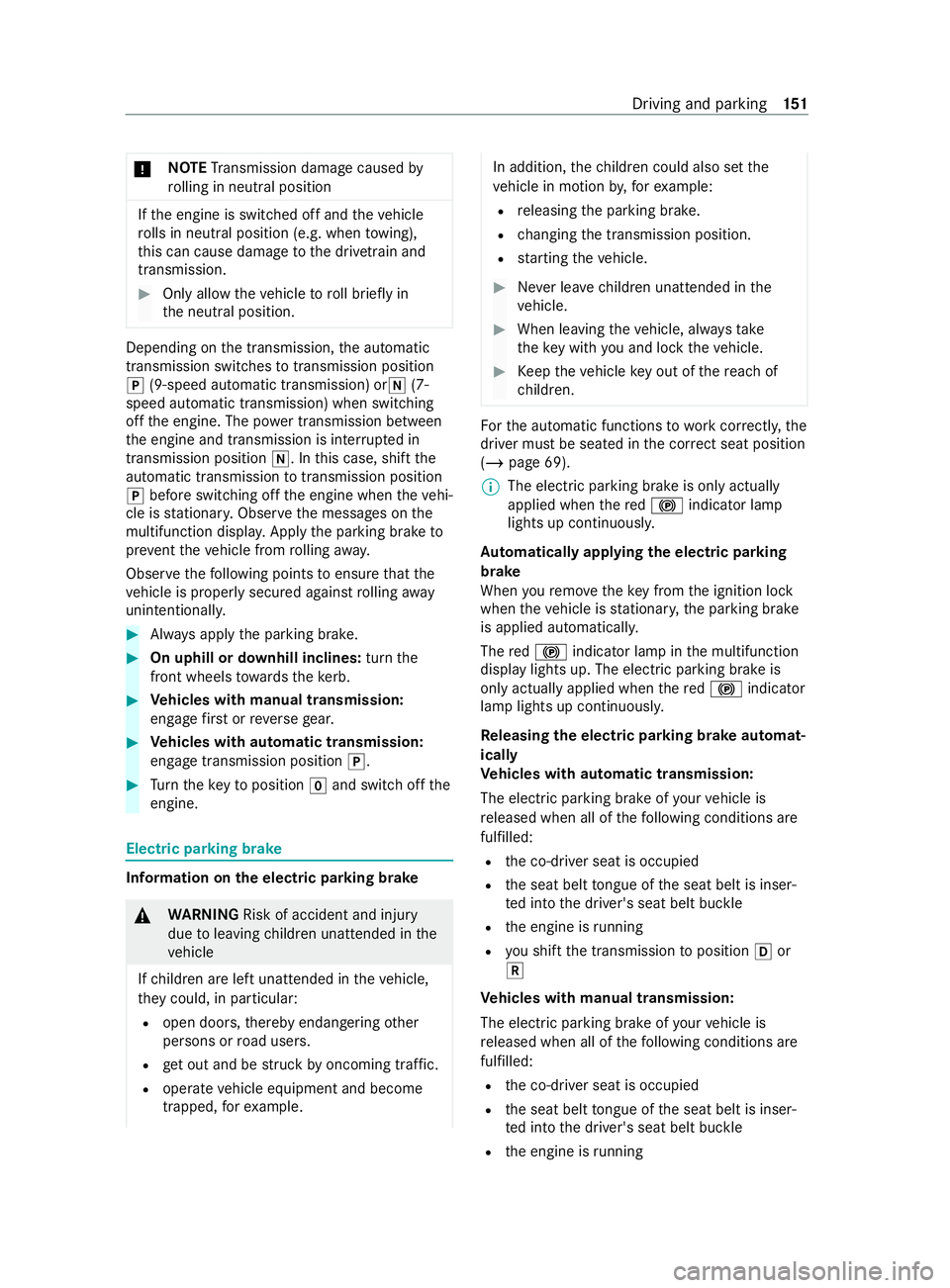
*
NO
TETransmission damage caused by
ro lling in neut ral position If
th e engine is switched off and theve hicle
ro lls in neut ral position (e.g. when towing),
th is can cause damage tothe driv etra in and
transmission. #
Only allow theve hicle toroll brief lyin
th e neutral position. Depending on
the transmission, the automatic
transmission switches totransmission position
005D (9-speed au tomatic transmission) or005C (7-
speed automatic transmission) when switching
off the engine. The po wer transmission between
th e engine and transmission is inter rupte d in
transmission position 005C. Inthis case, shift the
automatic transmission totransmission position
005D before switching off the engine when theve hi‐
cle is stationar y.Obser vethe messages on the
multifunction displa y.App lythe parking brake to
pr eve nttheve hicle from rolling away.
Obser vethefo llowing points toensure that the
ve hicle is properly secured against rolling away
unin tentionally. #
Always apply the parking brake. #
On uphill or downhill inclines: turnthe
front wheels towa rdsth eke rb. #
Vehicles with manual transmission:
engage firs t or reve rsege ar. #
Vehicles with automatic transmission:
engage transmission position 005D.#
Turn theke yto position 005Aand switch off the
engine. Electric parking brake
Information on
the electric pa rking brake &
WARNING Risk of accident and inju ry
due toleaving children unat tended in the
ve hicle
If ch ildren are left unat tended in theve hicle,
th ey could, in part icular:
R open doors, thereby endangering other
persons or road users.
R get out and be stru ck byoncoming traf fic.
R operate vehicle equipment and become
trapped, forex ample. In addition,
thech ildren could also set the
ve hicle in motion by,fo rex ample:
R releasing the parking brake.
R changing the transmission position.
R starting theve hicle. #
Never lea vechildren unat tended in the
ve hicle. #
When leaving theve hicle, alw aysta ke
th eke y with you and lock theve hicle. #
Keep theve hicle key out of there ach of
ch ildren. Fo
rth e automatic functions towo rkcor rectl y,the
driver must be seated in the cor rect seat position
(/ page 69).
% The electric parking brake is only actually
applied when
there d0024 indicator lamp
lights up continuousl y.
Au tomatically applying the electric parking
brake
When youre mo vetheke y from the ignition lock
when theve hicle is stationar y,the parking brake
is applied automaticall y.
The red0024 indicator lamp in the multifunction
display lights up. The electric parking brake is
only actually applied when there d0024 indicator
lamp lights up continuousl y.
Re leasing the electric pa rking brake automat‐
ically
Ve hicles with automatic transmission:
The electric parking brake of your vehicle is
re leased when all of thefo llowing conditions are
fulfilled:
R the co-driver seat is occupied
R the seat belt tongue of the seat belt is inser‐
te d into the driver's seat belt buckle
R the engine is running
R you shift the transmission toposition 005Bor
005E
Ve hicles with manual transmission:
The electric parking brake of your vehicle is
re leased when all of thefo llowing conditions are
fulfilled:
R the co-driver seat is occupied
R the seat belt tongue of the seat belt is inser‐
te d into the driver's seat belt buckle
R the engine is running Driving and pa
rking 151
Page 180 of 337
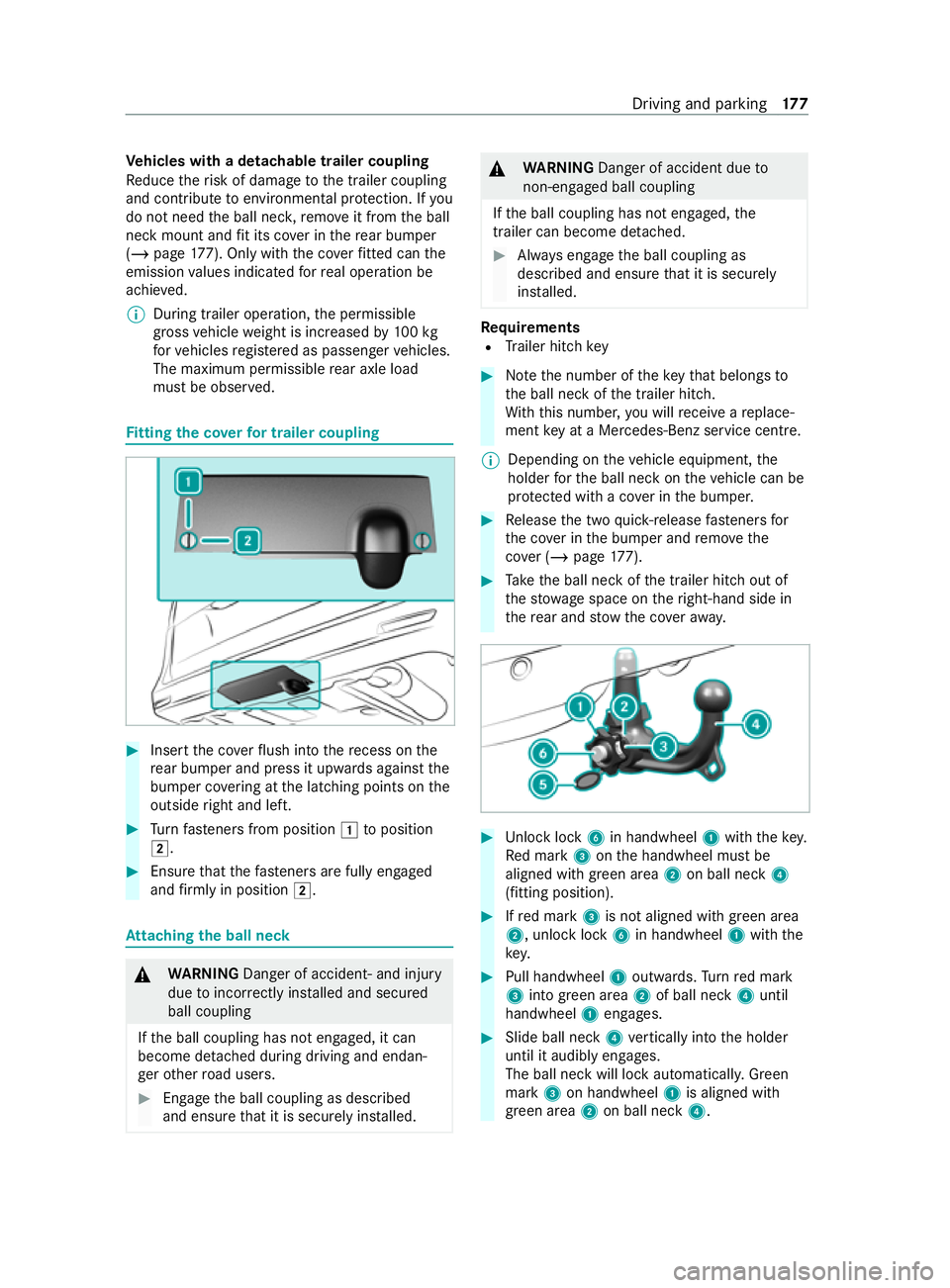
Ve
hicles with a detachable trailer coupling
Re duce therisk of damage tothe trailer coupling
and cont ribute toenvironmen tal pr otection. If you
do not need the ball nec k, removeit from the ball
neck mount and fit its co ver in there ar bumper
(/ page 177). Only with the co verfitted can the
emission values indicated forre al operation be
achie ved.
% During trailer operation,
the permissible
gross vehicle weight is inc reased by100kg
fo rve hicles regis tere d as passenger vehicles.
The maximum permissible rear axle load
must be obse rved. Fi
tting the co verfo r trailer coupling #
Inse rtthe co verflush into there cess on the
re ar bumper and press it upwards against the
bumper co vering at the latching points on the
outside right and left. #
Turn fast eners from position 0047toposition
0048. #
Ensure that thefast eners are fully engaged
and firm lyin position 0048. At
taching the ball neck &
WARNING Danger of accident‑ and inju ry
due toincor rectly ins talled and secured
ball coupling
If th e ball coupling has not engaged, it can
become de tach ed during driving and endan‐
ge rot her road users. #
Engage the ball coupling as described
and ensure that it is securely ins talled. &
WARNING Danger of accident due to
non-engaged ball coupling
If th e ball coupling has not engaged, the
trailer can become de tach ed. #
Always engage the ball coupling as
described and ensure that it is securely
ins talled. Re
quirements
R Trailer hit chkey #
Notethe number of theke yth at belongs to
th e ball neck of the trailer hitch.
Wi th th is numbe r,yo u will receive a replace‐
ment key at a Mercedes-Benz service centre.
% Depending on
theve hicle equipment, the
holder forth e ball neck on theve hicle can be
pr otected with a co ver in the bumper. #
Release the two quick- re lease fasteners for
th e co ver in the bumper and remo vethe
co ver (/ page177). #
Take the ball neck of the trailer hitch out of
th estow age space on theright-hand side in
th ere ar and stowthe co veraw ay. #
Unlock lock6in handwheel 1with thekey.
Re d mark 3onthe handwheel must be
aligned with green area 2on ball neck 4
(fitting position). #
Ifre d mark 3is not aligned with green area
2, unlock lock 6in handwheel 1with the
key. #
Pull handwheel 1outwards. Turn red mark
3 into green area 2of ball neck 4until
handwheel 1engages. #
Slide ball neck 4vertically into the holder
until it audibly engages.
The ball neck will lock automaticall y.Green
mark 3on handwheel 1is aligned with
green area2on ball neck 4. Driving and parking
17 7
Page 181 of 337
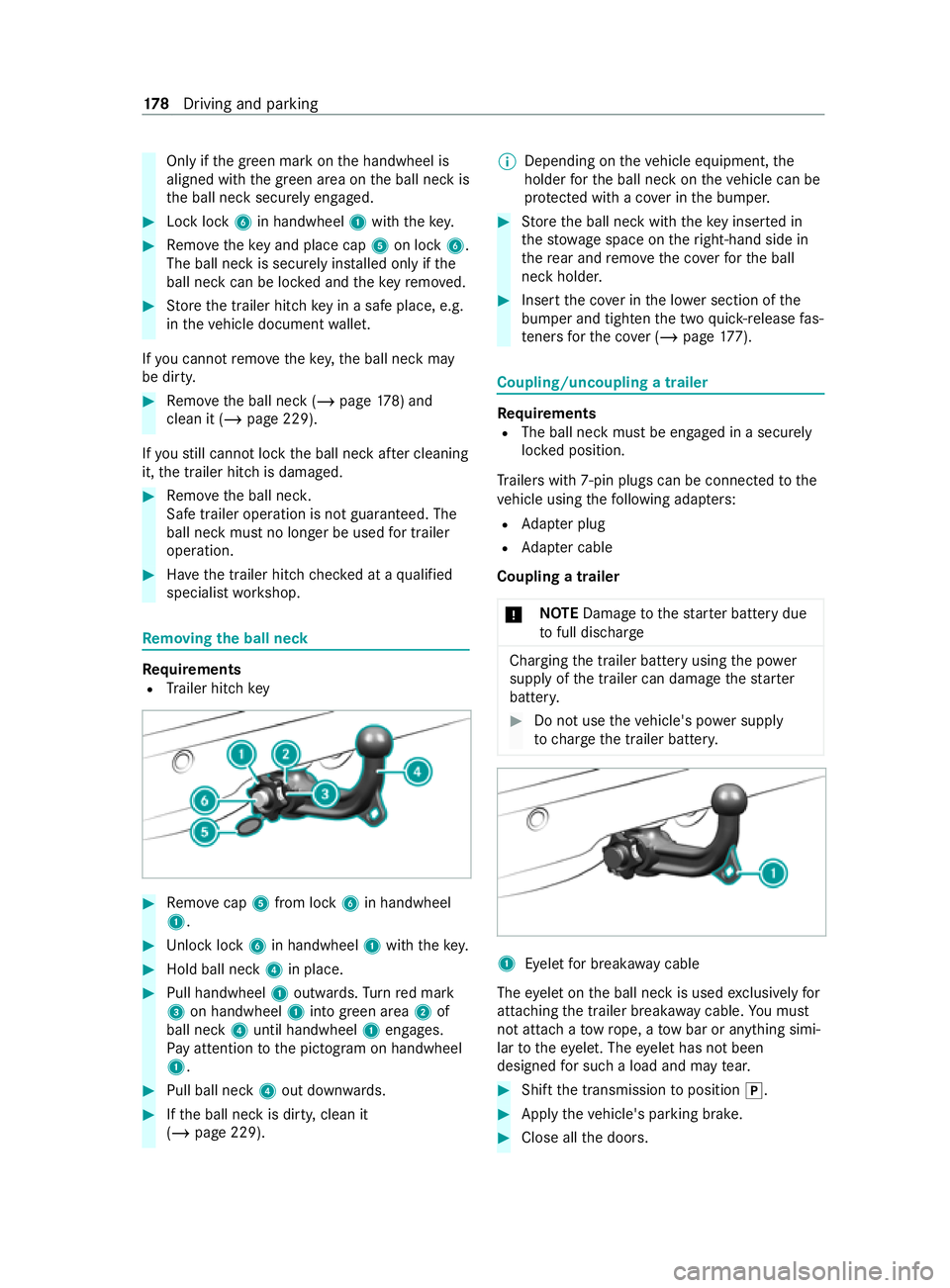
Only if
the green mark on the handwheel is
aligned with the green area on the ball neck is
th e ball neck securely engaged. #
Lock lock 6in handwheel 1with thekey. #
Remo vetheke y and place cap 5on lock 6.
The ball ne ckis securely ins talled only if the
ball neck can be loc ked and theke yre mo ved. #
Store the trailer hitch key in a safe place, e.g.
in theve hicle document wallet.
If yo u cannot remo vetheke y,the ball neck may
be dirty. #
Remo vethe ball neck (/ page178) and
clean it ( /page 229).
If yo ustill cannot lock the ball neck af ter cleaning
it, the trailer hitch is damaged. #
Remo vethe ball nec k.
Safe trailer ope ration is not guaranteed. The
ball neck mu stno longer be used for trailer
operation. #
Have the trailer hitch checked at a qualified
specialist workshop. Re
moving the ball ne ck Re
quirements
R Trailer hit chkey #
Remo vecap 5from lock 6in handwheel
1. #
Unlock lock 6in handwheel 1with th ekey. #
Hold ball neck 4in place. #
Pull handwheel 1outwards. Turn red mark
3 on handwheel 1into green area 2of
ball neck 4until handwheel 1engages.
Pa y attention tothe pictogram on handwheel
1. #
Pull ball neck 4out down wards. #
Ifth e ball neck is dirty, clean it
(/ page 229). %
Depending on
theve hicle equipment, the
holder forth e ball neck on theve hicle can be
pr otected with a co ver in the bumper. #
Store the ball neck with theke y inser ted in
th estow age space on theright-hand side in
th ere ar and remo vethe co verfo rth e ball
neck holder. #
Insert the co ver in the lo wer section of the
bumper and tighten the two quick- re lease fas‐
te ners forth e co ver (/ page177). Coupling/uncoupling a
trailer Re
quirements
R The ball neck must be engaged in a securely
locked position.
Tr ailers with 7-pin plugs can be connec tedto the
ve hicle using thefo llowing adap ters:
R Adapter plug
R Adapter cable
Coupling a trailer
* NO
TEDama getothest ar ter battery due
to full discharge Charging
the trailer battery using the po wer
supply of the trailer can damage thest ar ter
batter y. #
Do not use theve hicle's po wer supply
to charge the trailer batter y. 1
Eyeletfor break away cable
The eyelet on the ball neck is used exclusively for
attaching the trailer break away cable. You must
not attach a tow rope, a tow bar or anything simi‐
lar totheey elet. The eyelet has not been
designed for such a load and may tear. #
Shiftthe transmission toposition 005D. #
Apply theve hicle's parking brake. #
Close all the doors. 17 8
Driving and pa rking